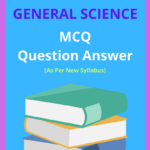Class 6 Science MCQ Chapter 16 Garbage in, Garbage Out Solutions, SEBA Class 6 Science MCQ Chapter 16 Garbage in, Garbage Out Notes to each chapter is provided in the list so that you can easily browse throughout different chapter Assam Board Class 6 General Science Multiple Choice Question Answer and select needs one.
Class 6 Science MCQ Chapter 16 Garbage in, Garbage Out
Also, you can read the SCERT book online in these sections Solutions by Expert Teachers as per SCERT (CBSE) Book guidelines. SEBA Class 6 Science MCQ Notes PDF. These solutions are part of SCERT All Subject Solutions. Here we have given Class 6 Science Objective Types Solutions for All Subject, You can practice these here.
Garbage in, Garbage Out
Chapter – 16
| MCQ |
1. Converting plants and animals waste including that from kitchen, into manure, is called?
(a) Vermi compost.
(b) Compost.
(c) Landfill.
(d) Recycled.
Ans: (b) Compost.
2. The method of making compost from kitchen garbage using redworms is called?
(a) Compost.
(b) Waste.
(c) Vermi compost.
(d) Garbage.
Ans: (c) Vermicompost.
3. Which one of the following will add to garbage?
(a) Wrappers of biscuit packet.
(b) Wrappers of chips packet.
(c) Tin of a cold drink.
(d) All of these.
Ans: (d) All of these.
4. Garbage from cities is collected at?
(a) Riverside.
(b) Landfill area.
(c) Play ground.
(d) No one of these.
Ans: (b) Landfill area.
5. From the following, which one can be used for making manure?
(a) Earthworms.
(b) Compost.
(c) Vermicompost.
(d) Garbage.
Ans: (a) Earthworms.
6. Red Worms need which of the following for survival?
(a) Compost.
(b) Plastic.
(c) Moisture.
(d) Dryness.
Ans: (c) Moisture.
7. Materials that can be recycled are collected in?
(a) Red bins.
(b) Blue bins.
(c) Pink bins.
(d) All of these.
Ans: (d) All of these.
8. Cleaners collect the garbage in trucks and take it to a low lying open area, called a?
(a) Garbage side.
(b) Landfill.
(c) River land.
(d) All of these.
Ans: (b) Landfill.
9. Leaves falling from trees should be disposed of by?
(a) Making compost by garbage.
(b) Making compost.
(c) Making compost by vermicompost.
(d) No one of these.
Ans: (c) Making compost by vermicompost.
10. Which is a paste of clay and paper?
(a) Plastic.
(b) Leader.
(c) Plaster-mache.
(d) Paper- mache.
Ans: (d) paper – mache.
11. Which one is non- biodegradable waste?
(a) Paper.
(b) Aluminum.
(c) Cotton.
(d) Plastic.
Ans: (b) Aluminum.
12. Instead of polythene bags we can use bags made of?
(a) Plastic bags.
(b) Leader bags.
(c) Paper bags.
(d) No one of these.
Ans: (c) Paper bags.
13. Redworms have a structure which helps them in grinding the food, it is called?
(a) Grinding.
(b) Gizzard.
(c) Surroundings.
(d) Burning.
Ans: (b) Gizzard.
14. From the following ,Which one is good for making compost?
(a) Plastic paper, toys, ballon.
(b) Polythene, leader bags.
(c) Piece of cloths, egg shells, plaster.
(d) Vegetables, leaves, fruits peels, egg shells.
Ans: (d) Vegetables, leaves, fruit peels, egg shells.
15. If you dump kitchen waste in a pit after sometime it may?
(a) Convert into compost.
(b) Convert into vermicompost.
(c) Dried forever.
(d) all of these.
Ans: (a) Convert into compost.

Hi! my Name is Parimal Roy. I have completed my Bachelor’s degree in Philosophy (B.A.) from Silapathar General College. Currently, I am working as an HR Manager at Dev Library. It is a website that provides study materials for students from Class 3 to 12, including SCERT and NCERT notes. It also offers resources for BA, B.Com, B.Sc, and Computer Science, along with postgraduate notes. Besides study materials, the website has novels, eBooks, health and finance articles, biographies, quotes, and more.




